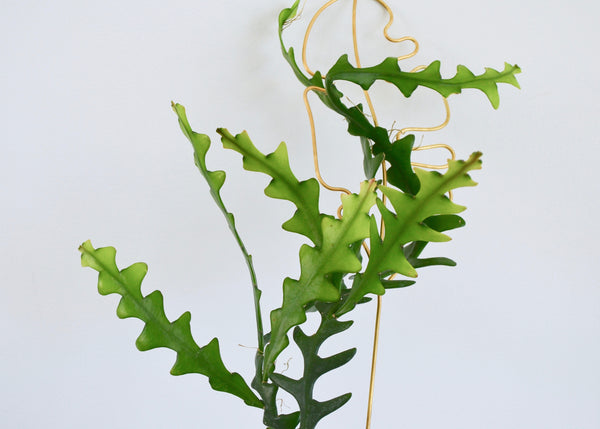Ric Rac Cactus: A Comprehensive Guide

Eccentric and aesthetically unique, the Ric Rac Cactus is an epiphytic plant– meaning that in the wild, they grow on other plants, trees, or substrates. This plant is also referred to as Fishbone plant and Zig-zag cactus. In preferred conditions, Ric Rac cactus can actually bloom a fragrant flower (typically in Fall season)! These cartoon-like cacti make wonderful houseplants because they’re low maintenance and make a statement in just about any space.
Scientific Name: Disocactus anguliger (syn. Epiphyllum anguligerum)
Common Names: Ric Rac cactus, Fishbone cactus, Zig-zag cactus, orchid cactus
Origin: Native to Mexico

About
Unlike desert cacti, the Ric Rac cactus originates from rainforest conditions of Mexico– enjoying warm, humid, rainy conditions. In that habitat, this plant latches onto crevices of trees where it grows and cascades downward. Similarly, as a houseplant, the Ric Rac cactus will typically be displayed in a hanging basket for the stems to dangle.
The stems of the Ric Rac cactus are vibrant green and almost skin like. The flat, variating lobed stems help create that distinct zig-zag pattern unique to this plant. And as the common name implies, resembles a fishbone. The inner portion of the stem is woody, and be weary of touching the outer stem which does have some tiny thorns.
Great for beginners or any plant parent that wants a special addition, the Ric Rac cactus checks all of the boxes. It’s easy to care for, can be quite forgiving, is pet-safe, and purifies indoor air.
Buy Online: Ric Rac Cactus— 4 Inch

Indoor Care:
Sun
Considering a plant's origins is always helpful when determining indoor plant care. Since the Ric Rac cactus is native to tropical rainforests, it will need moderate to bright sunlight– keeping in mind that indirect light is best. As an epiphyte growing under the canopy level, it’s typically protected from harsh, direct sunlight. In fact, too much sunlight can cause red tinged leaves. Typically the ideal spot for this plant to live in your home will be near a South facing window (some morning or evening direct sunlight should be ok).
Water
While it may seem to contradict what you know about cacti, the Ric Rac (since it isn’t a desert dweller) will enjoy moderate watering. Specifically, allow the soil to dry halfway down before watering the plant. Again considering the natural habitat where the Ric Rac’s roots are partially exposed, you’ll want to make sure your houseplant is not being oversaturated. Air flow to the roots is key to ensuring success with this houseplant. When you do water, make sure to do so thoroughly– that’s applying water until it starts to seep out of the bottom holes of the pot (always ensure that the plant is not sitting in any excess water as this can lead to root rot).
Repotting
Repotting the Ric Rac cactus will be far and few between. The thin, often delicate roots will take time (typically 2-3 years) before needing to be sized up. There are a few signs though to look out for that may indicate it’s time for a repot. First, if the roots have started to creep out of the bottom holes of the planter then it’s time to pot up to a planter that’s 1-3” larger in diameter. Or if you notice that the soil isn’t retaining any water and is flowing directly out of the pot, then it may be time for a soil refresh (especially if the soil is compacted or composition has degraded).
For more information on repotting find our guide here: Repotting 101.

Fertilizer
Fertilizer will be important for your Ric Rac cactus to continue growing and be happy and healthy. Fertilizing will also replenish the soil and potentially induce flowering. Of course it’s always imperative to remember that fertilizer should only be applied when it’s time (and too much can actually harm the plant in the short and long term).
We recommend using a water-soluble fertilizer diluted to half the recommended strength. Fertilize once every 3 months during spring through summer (so only about 3-4 applications per year).
Extra Tips:
Placing the plant outside during spring and summer could be beneficial for optimal growth! Especially when conditions are warm and humid (or anything that mimics more rainforest-esque conditions). Keep in mind that many houseplants, including the Ric Rac cactus, will not tolerate extreme temperatures– so bring the plant inside if temperatures dip below 50°F or above 90°F.
Pests
Scale and mealybugs are the most common houseplant pests that Ric rac cacti experience.
Toxicity
Ric Rac cacti are considered safe around cats, dogs, and humans! Just be careful of the hair-like spikes that could cause irritation.
My Zig Zag is a cutting from my daughter’s plant. After rooting mine has lovely thick zig zags while my daughter’s plant has lots more fronds but they are thin and not very zig zag. Same plant different looks….why?
It is unbelievable, but I had been searching for the name of that plant for a couple of weeks. I have a large one, but I forgot where it came from and the name. Mine grows quite long and has what looks to me like roots growing on the undersides of each stalk, leaf or whatever.